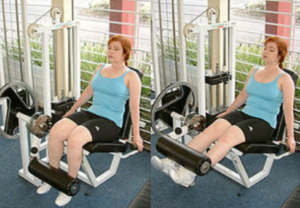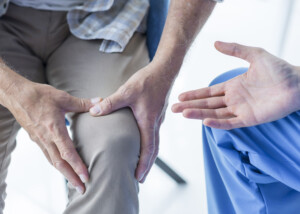
Isn’t that the oddest thing:
Your knee hurts climbing stairs but you can run all day long without any pain.
There’s a condition that can explain this.
“Chondromalacia, a degeneration of the underside of the knee cap, is often suspect,” says Dr. Tom Carpenter, corrective exercise specialist, certified personal trainer and chiropractor, inventor of Stand Corrected™, a portable harness-like stretching tool that helps alleviate back, neck and shoulder pain.
Chondromalacia is the wearing down of the cartilage located under the kneecap and is also known as “runner’s knee.”
Another name is “jumper’s knee,” as it’s no secret that volleyball and basketball players sometimes develop chondromalacia. But you need not be a jumping athlete to get this condition.
When the cartilage wears down, there is less cushioning of the joint, resulting in a dull aching type of pain under the kneecap.
Chondromalacia pain is not sharp, piercing or stabbing, but can range from a weakly dull ache to a strong ache. I know; I’ve had this condition, and I’ve cured it.
But in my case, it was running that brought on the knee pain, yet while climbing stairs — even bounding up steps two at a time — was painless.
Pain in the Knee Climbing Stairs

Freepik.com, jcomp
The increased flexion or bending of the joint forces the kneecap to glide up and down over the thigh bone (femur) more so than when you’re running.
For some people with chondromalacia, this will result in discomfort.
There are those especially unlucky people who experience pain with both climbing stairs and running.
In fact, there’s a third motion that chondromalacia infamously affects: kneeling so that your butt is against your ankles — a common position when gardening, in martial arts or in yoga. Even a deep squat can incite pain in some individuals.

Freepik.com
The cartilage is supposed to be smooth, and when it is, there is no pain.
Sometimes the cause of chondromalacia cannot be pinpointed, including in athletes who develop it gradually over time.
In my case, my first bout with chondromalacia was when I slipped on wet grass at age 17 when running to a base during softball.
The other knee developed it in a gradual fashion with no definitive cause.
You’re at risk for chondromalacia if you do a lot of running and/or jumping, and you already have less-than-ideal tracking of your patella (kneecap).
Additional Risk Factors
• Weak quadriceps muscles
• Hamstrings disproportionately weak, relative to quadriceps. A weightlifter may neglect hamstring workouts and focus too much on building the quads.
• Obesity
Very Effective Cure for Chondromalacia — Works Like a Charm
Leg extensions done against resistance will cure or at least really improve chondromalacia for many people who are patient and committed.
To get the ball rolling, sit on a chair that’s high enough so that your feet are not touching the floor.
Ideally the chair or stool will allow you to bend your legs further back so that your shin bone is past vertical.
Extend (straighten) both legs at once, aiming to get them parallel to the floor, but do not hyperextend. Toes should be pointing to ceiling (feet perpendicular to shins).
Lower to the start position. Repeat 10 times for three sets. Once you can do these without pain, move on to a leg extension machine (you’ll need to join a gym) where you can lift against resistance, beginning with the lightest load possible.
In short, a very effective treatment for chondromalacia is weighted leg extensions.

George Stepanek
This strengthens the quadriceps muscles, which in turn yield greater support to the knee. In my case the condition was outright cured.
However, you may have to do leg extensions for the rest of your life, or the chondromalacia may return.
But hey, with lifelong leg extensions, you’ll get shapelier and firmer legs!
While you’re rehabbing, avoid jumping, running or other activities that aggravate the knee pain.
Second Exercise for Chondromalacia
• Place a fitness ball against a wall.
• Stand back against it, back upright (don’t lean forward).
• Have feet out in front of you, shoulder-width apart, legs straight, wearing supportive footwear.
• Lift front of feet off floor, keeping legs straight, so that only your heels are in contact with the floor; then place front of feet back on floor.
• Repeat 20 times. Do three sets.
If these two exercises don’t work, a physical therapist can help you.
Being overweight is an impediment to recovering from chondromalacia, so it’s important to lose excess body fat.
Dr. Carpenter recommends ice and rest, but keep in mind that you will need to inherently improve the integrity of the joint with the right exercises.
In addition to the above, an overall fitness regimen is your best weapon against pain in the knee when climbing stairs but not during running.
So if you’re an avid runner who hasn’t been strength training, it’s time to strength train.
In addition to the leg extension do hamstring curls, leg presses, walking lunges (as tolerated) and half-squats — in which your thighs are parallel to the floor.
There’s no need to go deeper if it hurts your knees.
Never try to “run through” knee pain if your chondromalacia begins acting up when running.
Additional Causes of Knee Pain when Climbing Stairs but Not During Running
“If the pain occurs going down stairs, it could be an ACL, patellar tendon or arthritis issue,” says Dr. Carpenter.
As for pain in the knee when going up a staircase but not when you run, Dr. Carpenter says that “other causes should be considered, such as an imbalance of the supporting muscles involved with the knee, over-tightening of the IT band, Osgood-Schlatter disease, displacement of the kneecap which could be related to an arch problem of the foot, or bursitis in the knee.”

Photo credit: Aleesia Forni









































